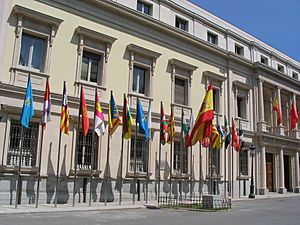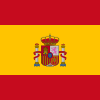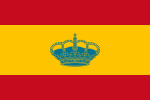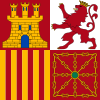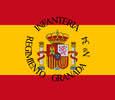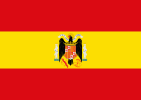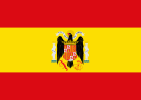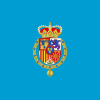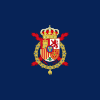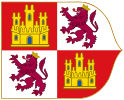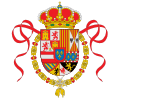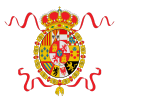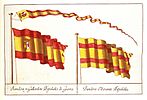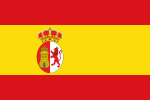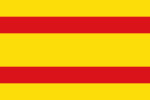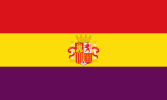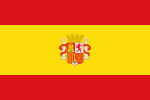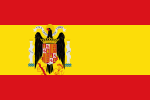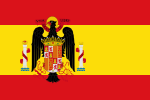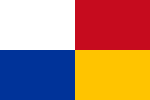Flag of Spain facts for kids
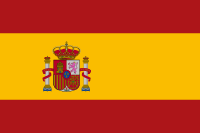 |
|
| Name | Rojigualda |
|---|---|
| Use | National flag and ensign |
| Proportion | 2:3 |
| Adopted | 15 May 1785 (original version, as naval and coastal fortifications' ensign) 5 October 1981 (current version, as established in the Spanish Constitution) |
| Design | A horizontal triband flag of red, yellow (double width) and red; charged with the Spanish coat of arms off-centred toward the hoist. |
| Designed by | Antonio Valdés y Bazán |
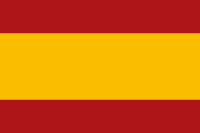
Variant flag of Kingdom of Spain
|
|
| Use | Civil flag and ensign |
| Proportion | 2:3 |
| Adopted | 28 May 1785 (original naval ensign version) 5 October 1981 (current version, changed coat of arms) |
| Design | Two horizontal stripes of red (top and bottom) and yellow (middle). The yellow stripe is twice the size of the red stripes. |
| Designed by | Charles III |
The flag of Spain (called Bandera de España in Spanish) has three horizontal stripes: red, yellow, and red. The yellow stripe in the middle is twice as wide as each red stripe. People often call it la Rojigualda, which means "red-weld" (weld is a yellow dye).
This flag design started in 1785 as a flag for the Spanish navy, chosen by Charles III of Spain. It was designed by Antonio Valdés y Bazán. For about 50 years, it was mostly used by the navy, flying over ships and coastal forts. Later, during the Peninsular War, it also appeared with marine soldiers fighting on land. The flag became the official national flag for land use in 1843, thanks to Queen Isabel II of Spain.
Through the 1800s and 1900s, the red and yellow colors stayed the same. The only big change was during the Second Spanish Republic (1931–1939), when a different color was added.
Contents
What the Law Says About the Spanish Flag
The laws that explain how the Spanish flag should look and be used are:
- The Spanish Constitution of 1978: This important document says what the national flag looks like.
| La bandera de España está formada por tres franjas horizontales, roja, amarilla y roja, siendo la amarilla de doble anchura que cada una de las rojas. Artículo 4 1 de la constitución española de 1978 |
|
Translation: |
- Act 39/1981: This law explains how to use the flag.
- Royal Decree 441/1981: This rule gives the exact details for the flag's colors.
- Royal Decree 1511/1977: This rule sets out how flags, banners, and emblems should be used.
Flag Colors and Design
The official colors of the flag are set by a Royal Decree from 1981. The main colors are a specific shade of red and a bright yellow, sometimes called "weld-yellow."
The design of the flag, especially where the Spanish coat of arms goes, is also very specific:
- The coat of arms is 2/5ths (two-fifths) of the flag's height.
- It appears on both sides of the flag.
- If the flag has normal proportions (length 3/2 of its width), the coat of arms is placed closer to the flagpole, about half the flag's width from the edge.
- If the flag is shorter than usual, the coat of arms is placed right in the middle.
How to Use the Spanish Flag
The Spanish flag is usually flown horizontally from public buildings, homes, businesses, and ships. It's also used during official events.
- Flags should fly from sunrise to sunset.
- Government offices in Spain and abroad must fly the flag 24 hours a day. If it's dark, the flag needs to be lit up.
- Flags must always be clean and in good condition.
When someone important passes away, the flag can be flown in two ways to show respect:
- Half-mast: The flag is raised to the very top of the flagpole, then lowered to about one-third of the way down.
- Black ribbon: If the flag is always attached to a pole, a black ribbon (10 centimeters wide) can be tied to the pole. The ends of the ribbon should reach the bottom of the flag.
During funerals, the flag might cover the coffins of government officials or soldiers. After the ceremony, the flag is folded and given to the family.
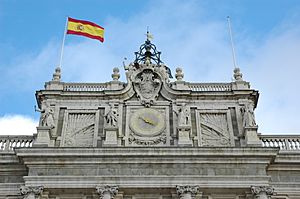
When the Spanish flag is flown with other flags, there's a special order:
- The national flag of Spain.
- Flags of other countries.
- The flag of Europe.
- Flags of international groups (like NGOs).
- Military and government flags.
- Flags of Spain's regions.
- City flags and any others.
If foreign flags are used, they are usually put in order by their country's name in Spanish. The flag of Europe is always flown because Spain is part of the European Union. The NATO flag can also be used since Spain is a member of NATO.
The Spanish national flag should always be the largest and in the most important spot when flown with other flags.
Other Flags Used in Spain Today
Flags for Officials
Some important government officials in Spain, like the president or ministers, have their own special flag. It's a square version of the Spanish flag with the Spanish coat of arms in the center of the yellow stripe.
Yacht Flag
Boats and yachts in Spain use a special flag called the Yacht ensign. It's the Spanish flag with a blue royal crown in the middle of the yellow stripe. This flag was first used in 1875.
The Spanish naval jack is a special flag flown at the front of Navy ships.
- It's used when ships are docked or anchored in foreign waters, from morning to evening.
- In Spanish waters, it's flown on Sundays, holidays, and when a foreign warship is present.
- The main national flag is always flown at the back of the ship.
The naval jack is a square flag with four sections:
- The first section shows a gold tower on a red background (for Castile).
- The second section shows a red lion on a silver background (for León).
- The third section has four red stripes on a gold background (for Aragon).
- The fourth section has gold chains on a red background (for Navarre).
Flags for the Armed Forces
The Spanish Armed Forces use the same national flag. However, military units often use a more square version of the flag. This flag also has the name of the unit written on it.
Royal Standards of Spain
The King of Spain uses a flag called the Royal Standard. It's a crimson (deep red) square flag with the King's coat of arms in the middle. You can see it flying at the King's home, the Palacio de la Zarzuela, and on his official car.
There's also a Royal Guidon, which is a military flag for the monarch. It looks almost the same as the Royal Standard but has a gold fringe around the edges. It's made of silk and is 80 cm by 80 cm. This flag is carried close to the King.
The heir to the throne, the Princess of Asturias, also has her own standard and guidon. The Standard of the Princess of Asturias is a light blue square flag with the coat of arms of the Princess of Asturias in the center. Her guidon is similar but with a gold fringe.
History of the Spanish Flag
-
Pennant of the Catholic Monarchs (until 1492)
-
Standard of the Crown of Castile
-
Standard of the Crown of Aragon
In the Middle Ages, countries didn't have "national flags" like we do today. Instead, they used royal shields and banners with symbols of their kings or armies.
Early Kingdoms and the Catholic Monarchs
Before Spain was united, different kingdoms had their own symbols.
- The flag of the Crown of Aragon was yellow with four red stripes. You can still see these stripes in the flags of places like Aragon, Catalonia, and Valencia today.
- The Crown of Castile used a flag that mixed symbols of Castile (a gold tower) and León (a purple lion).
When the Catholic monarchs (King Ferdinand and Queen Isabella) united their kingdoms in 1475, they combined these symbols. The banner of Castile and León was actually the first European symbol to arrive in the New World (the Americas).
The Cross of Burgundy

The Cross of Burgundy came to Spain in 1496 through the marriage of Joanna of Castile and Philip the Handsome. This flag, with its red, jagged cross that looks like two crossed branches, became a very important symbol for Spain, even though it came from another country. It was often shown on white or yellow flags. Spanish armies used flags with the Cross of Burgundy, and it even appeared on military uniforms.
Habsburg Rulers
When the Habsburg family ruled Spain in the mid-1500s, each military company had its own flag, usually with the commander's coat of arms over the Cross of Burgundy. The King also had a special yellow flag called the "Coronela" with his imperial shield.
Philip II ordered that each army unit (called a Tercio) should have a yellow flag with a red Cross of Burgundy. Smaller versions, called banners, were used by cavalry.
At this time, there wasn't one single "national flag." The King's royal coat of arms was the main symbol of Spain. Other flags were also used, like the green flag the Emperor used when he conquered Tunisia.
The Bourbon Dynasty and New Designs
When Philip V became king in 1700, he was from the Bourbon family. He changed the royal arms and also started to give Spain a more unified flag. He put the Cross of Burgundy and the Royal coat of arms on a white flag. This wasn't a national flag yet, but it was a step towards one.
The Birth of the Current Flag: Charles III
-
The flags chosen by Charles III in 1785 as war and merchant ensigns
In 1760, Charles III changed the royal coat of arms again. He noticed that many European countries used mostly white flags, which caused confusion during sea battles. So, he asked his Navy Minister to design new flags that would be easy to see from far away.
The flag he chose for the navy (a "war ensign") is the direct ancestor of today's Spanish flag. It had three stripes: red, yellow, and red, with the yellow stripe being twice as wide. This unique design made it stand out from other flags. For merchant ships, he chose a flag with five stripes: yellow-red-yellow-red-yellow.
The Second Spanish Republic Flag

In 1931, Spain became the Second Spanish Republic, and the monarchy ended. A new flag was adopted to show this change. It had three equal horizontal stripes: red, yellow, and a dark purple color (called morado). The purple stripe was added to represent the region of Castile and León, while the red and yellow represented the former Crown of Aragon. This flag had the coat of arms of the Second Spanish Republic in the center.
The Spanish State Flag (Franco Era)
-
Flag of Spain under Franco (1936–1938)
The Spanish Civil War ended in 1939, and Francisco Franco became the leader of Spain. The red and yellow flag was brought back. In 1938, a new coat of arms was added to the flag, featuring an eagle (representing John the Evangelist) and the Pillars of Hercules. This design was inspired by the coat of arms used by the Catholic Monarchs. This flag was used until 1977.
Return to the Current Flag
After Franco's death in 1975, Spain began a transition back to a democracy and a monarchy under King Juan Carlos I. In 1977, a slightly changed flag was approved, with a different eagle design. Finally, on December 19, 1981, the national flag of Spain received its current coat of arms, as described in the Spanish Constitution of 1978.
Unofficial Flags
-
Spanish flag with the Sacred Heart used by Carlism
- You might see an unofficial version of the Spanish flag with an Osborne bull on it, especially at sports events. This has become very popular.
- The flag of the Second Spanish Republic (with the indigo stripe) is sometimes seen at rallies by people who support republican ideas or are against the monarchy.
- A Spanish flag with a kicked football was the symbol for the 1982 FIFA World Cup.
- The red and yellow colors in the Shell Oil Company logo are thought to be inspired by the Spanish flag, because Shell built early gas stations in California, which has strong historical ties to Spain.
- The Spanish flag is also shown on the back of the Texas state seal and on the seal of Mobile, Alabama, as a reminder of Spain's historical influence in those areas.
See also
 In Spanish: Bandera de España para niños
In Spanish: Bandera de España para niños



